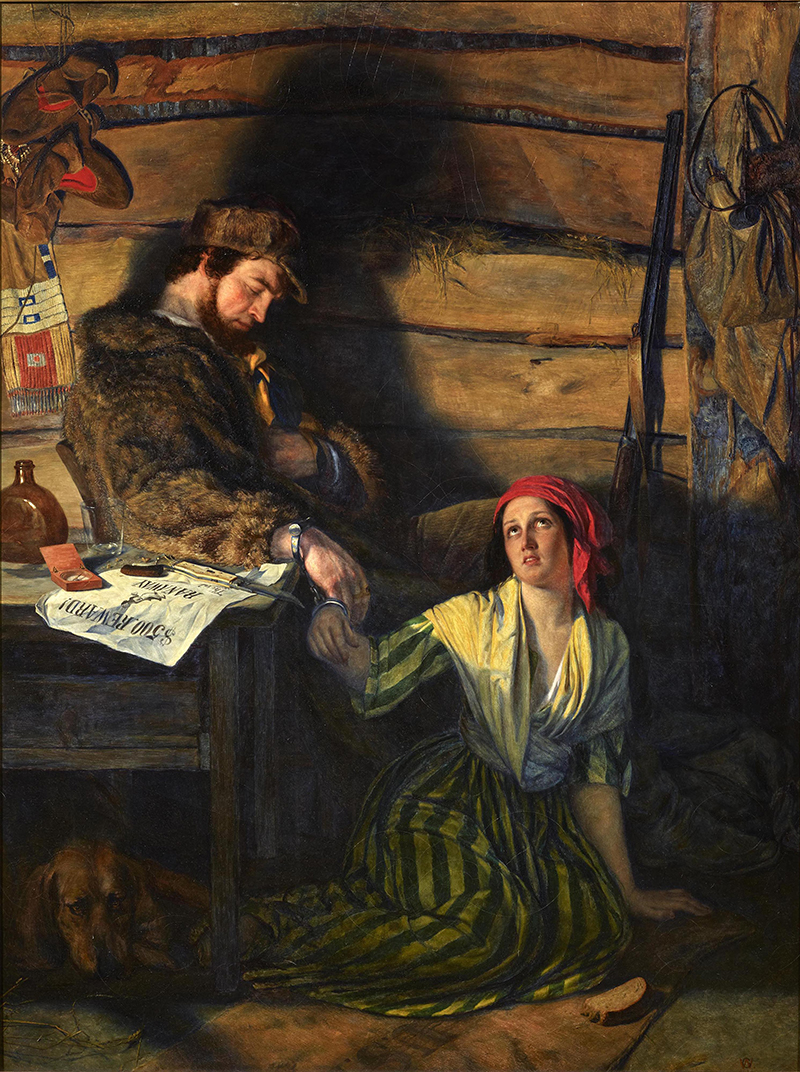Museum Acquires Rare 19th-Century Abolitionist Painting
By Bowdoin College Museum of Art
The Captured Runaway, 1856, oil on canvas by William Gale, British, 1823-1909. Museum purchase, Lloyd O. and Marjorie Strong Coulter Fund.
William Gale’s The Captured Runaway (1856) shows a mixed-race African-descended enslaved woman handcuffed to a bounty hunter. His female character wears the standard striped cotton dress and red turban in which slaves were often illustrated. She sits on a U.S. Mail sack, with a piece of nibbled bread on the floor next to her, suggesting that she is less concerned with earthly matters. Her beseeching eyes look upward, perhaps delivering a subtle Christian message, similar to that in abolitionist fiction, and mirroring the evangelical tone sometimes associated with the anti-slavery movement.
Gale’s slave catcher wears a raccoon coat and hat, and on the table rests his open hunting knife, an empty glass and a bottle, an open compass and an unfurled reward poster. The Native American moccasins hanging on the wall at left situate the scene, in haunting fashion, in North America. To the right, the slave catcher’s rifle and gunpowder horn appear, emphasizing the hunt of his human prey. All of these accoutrements indicate that this malefactor travelled north and is now pausing during the long return journey south with his valuable bounty. His trusted bloodhound rests on the floor under the table but, instead of being a symbol of kind fidelity as is so often the case with dogs in Victorian genre paintings, here the animal is transmuted into an emblem of the chase. Gale has gone to great lengths to set the dramatic scene, highlighting the hopeless plight of this courageous enslaved women, but with the suggestion that escape could again be possible, the slumbering slave catcher and his knife within her reach. The light in the cabin focuses the viewer’s attention on the face of the girl and renders the profile of the slave catcher in a monstrous amorphous shadow on the wall.
The Captured Runaway demonstrates the Victorian interest in the contemporary abolitionist movement. The Fugitive Slave Act of 1850 dictated that runaway slaves could be extradited to the South and that northerners were required by law to take a role in the vigilance. Gale alludes to the odious legislation, nicknamed the “Bloodhound Law,” through the presence of the namesake dog in his painting. Largely seen as a measure taken by the northern states to pacify their opponents, the law strengthened the power and authority of slave owners. To facilitate the capture of runaways, bounty hunters flooded the North, hoping to earn the standard 5% commission for every slave returned to his or her owner. Whereas before 1850, states could determine their own laws concerning the official assistance of slave catchers, the new law of 1850 mandated that a fine be levied against any U.S. Marshall or other official if they did not arrest an alleged runaway slave, and that anyone assisting a runaway could be arrested, fined, and imprisoned.
This and other laws spurred abolitionist writers and artists in the United States and Europe. In particular, Harriet Beecher Stowe’s novel Uncle Tom’s Cabin (1852), written here in Brunswick, Maine, won immediate popularity. Stowe’s novel centers on Uncle Tom, an older enslaved man, and his many acquaintances, moralizing against the enslavement of human beings. While The Captured Runaway does not illustrate a particular scene from Uncle Tom’s Cabin, Gale probably hoped for his painting to resonate with admirers of Stowe’s story, highlighting the travails of her character, Eliza, an enslaved woman of mixed race, who escapes the horrors of her bondage.
Gale was born and worked in London. During the nineteenth century, many in Great Britain felt a strong affinity for the plight of enslaved individuals, celebrating the successful escape of many runaways to the British colony of Canada, where laws protected the freedom of fugitives, as slavery had been made illegal in the British Empire in 1834. In the mid-nineteenth century, courageous men, women, and children could gain their freedom assisted by a system known as the Underground Railroad, whereby individuals and groups of fugitives were passed from one safe house to another, and which was operated and aided by anti-slavery proponents. Possibly as many as 100,000 enslaved individuals made this journey to freedom via the “Railroad,” with activities much accelerated as a result of the Fugitive Slave Act.
Fleeing slavery was a singular act of resistance and demonstrated Black women and men taking fate into their own hands. But running away was also difficult to accomplish. The challenges of leaving family behind, remaining undetected, finding food, and making one’s way to freedom meant that many did not succeed. Although Gale’s painting is not based on an eyewitness account, it nonetheless stands in direct opposition to slavery and to the endorsed federal powers to pursue escaped slaves following the 1850 Act. In Europe and the United States, there were few abolitionist artists, as most veered away from such political themes. The few surviving examples of abolitionist art represent the visual culture of the anti-slavery movement and illustrate the trauma and exploitation associated with the slave trade. These were the stories of strength and courage connected to so many who sought freedom and radical change. White and Black abolitionists on both sides of the Atlantic mobilized those experiences and the power of narrative to bring about an end to slavery.
We are pleased that this most recent addition to the Museum’s collection of nineteenth-century art is now on view in the exhibition Re-Framing the Collection: New Considerations in European and American Art, 1475-1875. We look forward to sharing it with you.
Frank GoodyearCo-Director, Bowdoin College Museum of Art